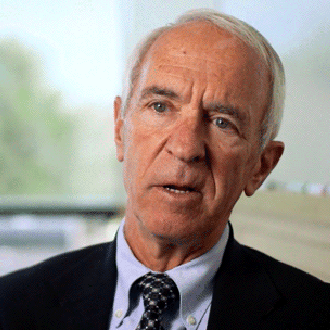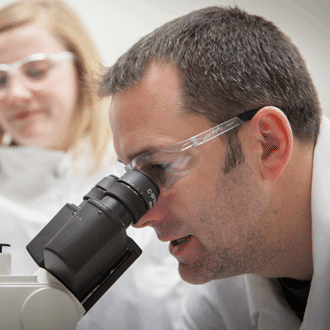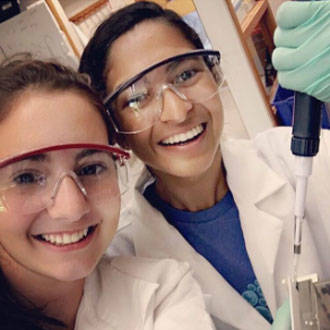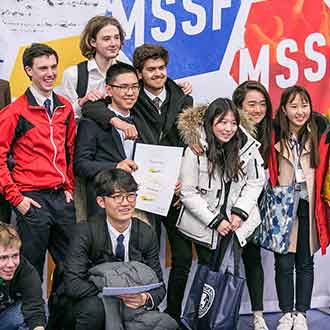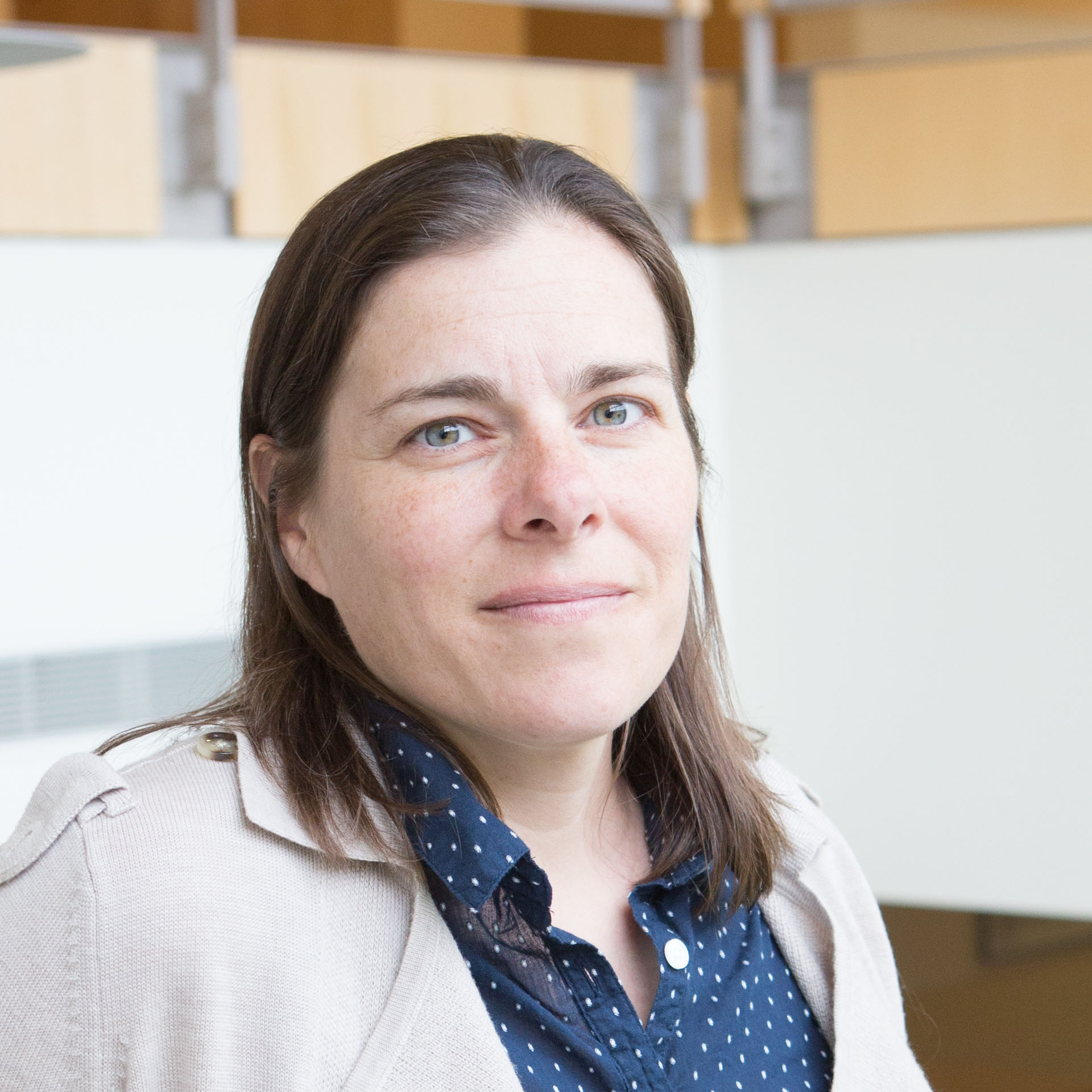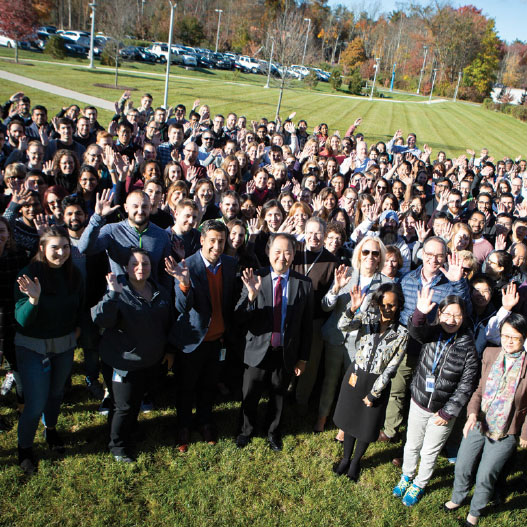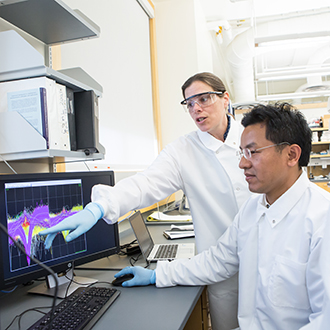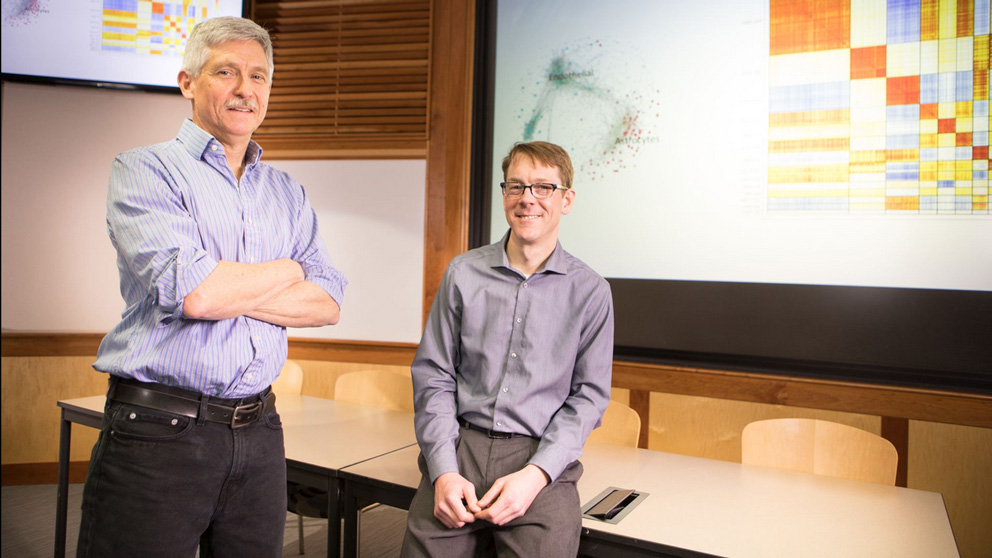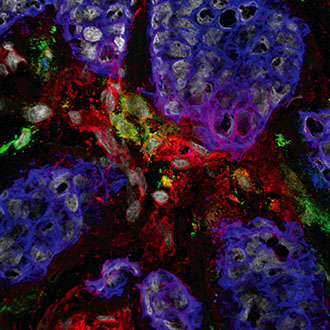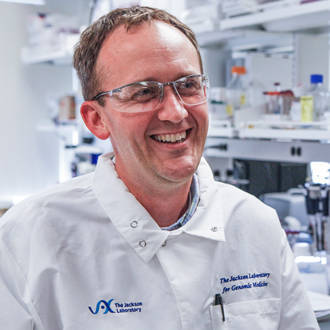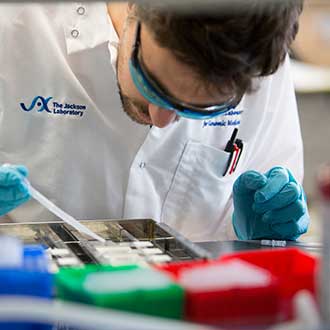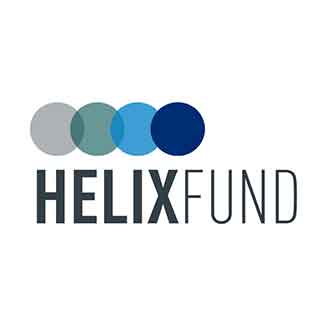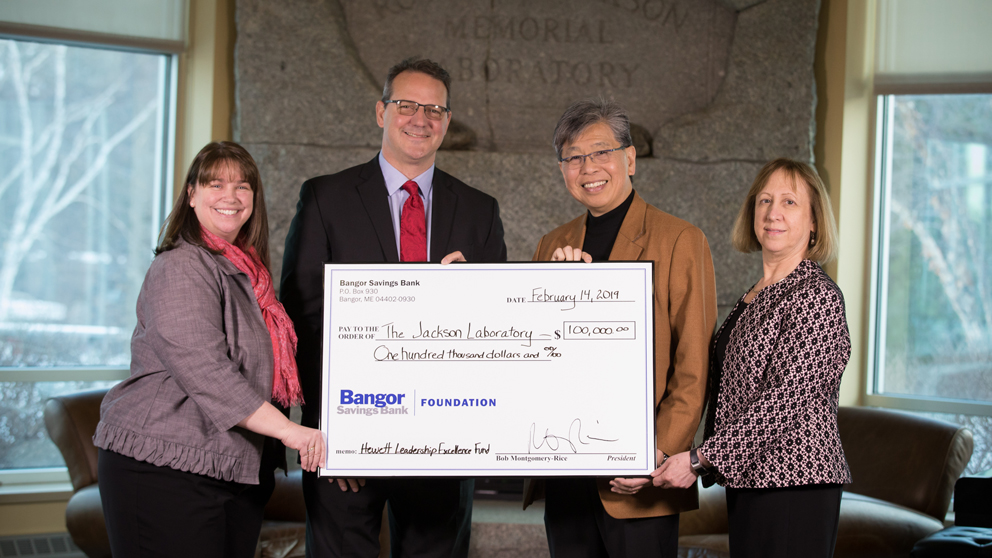Empowering Medicine2018 Annual Report

Dear Friends,
I am pleased to present you with the 2018 Annual Report from The Jackson Laboratory (JAX), which highlights some of the major events and accomplishments of the year.
Undoubtedly the biggest highlight of the year was the opening of the Charles E. Hewett Center in Ellsworth. This state-of-the-art vivarium, named in honor of our recently retired executive vice president and chief operating officer, significantly expands JAX’s capacity for producing the mouse models of human health for which we are best known.
JAX’s growth in 2018 was not confined to Maine. Our Farmington, Conn. campus has grown rapidly since the building opened in 2014 and thanks to surpassing targets for employment, grant funding, and other benchmarks of success, in 2018 the state of Connecticut announced forgiveness of the loans that helped launch our genomic medicine campus.
Our strong financial performance enabled us to continue investing in innovative science, particularly important with a large number of junior faculty at both our Bar Harbor and Farmington campuses. Seed funding — supported by operating surplus reinvested into our mission and by philanthropy — plays a vital role in launching new faculty research programs and positioning them to be competitive for larger federal grants.
The Laboratory’s eighth endowed faculty chair was established in 2018 through a generous gift from the Diana Davis Spencer Foundation. Associate Professor Gareth Howell, Ph.D., whose research focuses on neurodegeneration in glaucoma, Alzheimer’s disease and other conditions, was appointed as the inaugural Diana Davis Spencer Foundation Chair for Glaucoma Research.
As always, JAX derives its strength from our talented and dedicated staff, from the innovative science conducted on our campuses, from our mice and the unique role we play in the global scientific community, and from the generous support of friends who share our vision for a healthier future.
Thank you for helping us make 2018 a landmark year of growth and discovery for the Laboratory. With your support, we will achieve even greater things in the years ahead.
Warm regards,
Edison Liu, M.D.
President and CEO
CommunityInitiatives
JAX scholarships
Many promising students are unable to pursue higher education on account of the financial burden a college education presents. The JAX College Scholarship Program awarded a $10,000 scholarship to three students from under served backgrounds who will pursue a college degree and aspire to a career in biomedicine.
This annual program is open to graduating high school seniors who live in Connecticut or Maine, or in Sacramento County, Calif. One student from each location is awarded this scholarship.
The 72nd annual Maine State Science Fair, organized by The Jackson Laboratory and Maine Mathematics and Science Alliance, took place in March and included hundreds of students from across Maine. High school students competed for coveted state titles and more than $500,000 in scholarships and awards.
The Jackson Laboratory hosted three STEM (science, technology, engineering and math) open house events, one in Maine and two in Connecticut. These events brought hundreds of science-interested high school students and their parents and teachers to our campuses.
Current high school and undergraduate interns at JAX presented research that they have been conducting over the course of the academic year. Attendees also heard from JAX scientists who gave talks about their research and participated in a lively question-and-answer session.
Celebrating man's best friend
The Jackson Laboratory was the featured collaborator of a 2018 Bark for Life event in Connecticut. Bark for Life is an American Cancer Society event that honors the care-giving qualities of our canine family while raising money for lifesaving cancer research, advocacy, education and patient service programs.
Bark for Life celebrates the unique and healing bond between humans and their dogs, while contributing to the fight against cancer. A JAX team showed attendees how canines are helping to cure cancer through our Tallwood Cancer Canine Research Initiative.
Tackling Alzheimer's
Alzheimer’s disease is a debilitating, degenerative brain disease, causing short-term memory loss and, as it progresses, motor function and long‑term memory loss. In February, The Jackson Laboratory and the Alzheimer’s Association, Maine Chapter co-hosted a discussion about the complexities of Alzheimer’s disease, to share the latest research and bring together a community of scientists and those whose lives are affected by Alzheimer’s. The event included U.S. Senator Susan Collins (R-ME).
JAX sponsored the 21st Annual Dementia Education Conference organized by the Connecticut Chapter of the Alzheimer’s Association in April at Mohegan Sun. JAX Alzheimer’s researchers presented “Genetics, Environment and Alzheimer’s Disease Susceptibility” to more than 1,000 attendees, where they discussed how behaviors and genetic differences affect the brain and may contribute to Alzheimer’s onset as well as what they reveal about disease pathways.
In collaboration with the Alzheimer’s Association Maine, Connecticut and Northern California chapters, the JAX team is building upon its promising research to reach another population impacted by Alzheimer’s disease: caregivers. In April, more than 100 JAX employees volunteered to complete projects to help families impacted by Alzheimer’s disease in Maine, Connecticut and California.
In Maine, 60 volunteers created care packages to help make Alzheimer’s caregivers — who often spend much of their daily lives focused on helping their family members — feel pampered. Volunteers also helped with spring cleanup projects in Bangor and Ellsworth.
In Connecticut and California, 34 volunteers and 36 volunteers, respectively, spearheaded statewide spring cleanups for caregiver families. They raked yards, prepared soil for spring gardens, cleaned windows and did a variety of other outdoor chores, allowing caregivers to take these tasks off their “to do” lists.
U.S. Senator Angus King (D-ME) hosted a round‑table discussion about Alzheimer’s disease, which included JAX researchers Catherine Kaczorowski, Ph.D., and Greg Carter, Ph.D., along with the chief of neuropsychiatry at Acadia Hospital and Northern Light Eastern Maine Medical Center, and the executive director of the Maine Chapter of the Alzheimer’s Association.
In June, a team of 36 JAX employees donned purple shirts and visited Bar Harbor’s downtown restaurants, stores and businesses to kick off an initiative to help make the island dementia-friendly. The project was part of the Alzheimer’s Association’s The Longest Day® event to help raise awareness for Alzheimer’s care and support, and advance research.
The team worked to help educate restaurant and store owners and staff about Alzheimer’s. They hope to ensure people with dementia can live independently for as long as possible and are able to engage in a variety of activities in their home towns.
Growthand Expansion
Introducing the Charles E. Hewett Center
In August, The Jackson Laboratory celebrated the ribbon cutting of its state-of-the-art vivarium in Ellsworth, Maine, which will enable wider access to vital JAX mouse resources for the worldwide biomedical research community. The Charles E. Hewett Center represents the culmination of nine decades of unmatched experience and leadership in breeding and caring for laboratory mice.
The center is named in honor of The Jackson Laboratory’s transformational former Executive Vice President and Chief Operating Officer Charles E. Hewett, Ph.D. Hewett’s accomplishments included launching numerous research products and services; completing new research laboratories in Bar Harbor; expanding and relocating the Laboratory’s California operations; conceiving and leading the development of The Jackson Laboratory for Genomic Medicine in Farmington, Conn.; and establishing the vision for the new mouse production facility in Ellsworth.
Hewett has been a strong champion for JAX employees and has also worked tirelessly for their fitness and health, outstanding benefits, and competitive salaries and wages.
“We are proud to be headquartered in Maine, where we are one of our state’s largest private employers, bringing in more than $800 million in economic activity each year and providing more than 2,200 jobs,” Hewett says. “We look forward to partnering with the Ellsworth community to advance vital biomedical research around the world."
JAX Genomic Medicine: Five years, tenfold growth
When JAX broke ground on its new genomic medicine facility in Farmington, Conn., in 2013, there were only 30 employees.
As of the end of 2018, The Jackson Laboratory for Genomic Medicine onboarded more than 350 researchers, technicians and staff from around Connecticut and the world. This includes 173 senior scientists with 26 faculty members leading research programs in cancer, genomic structure and regulation, human genetics, computational biology, gene editing, immunology, human microbiome, cellular engineering, and infectious disease. Some of the new top scientists were recruited with UConn Health and Connecticut Children’s Medical Center, which further strengthens our ties with key regional collaborators. This significant growth and the more than $70 million in external research grants awarded since the opening of the Farmington facility are clear measures of JAX’s success.
The vision for creating JAX’s genomic medicine campus, built upon JAX’s mammalian genetics expertise to discover the precise genomic causes of human disease and develop individualized diagnostics, treatments and cures, has been truly transformational.
“In just five years, The Jackson Laboratory for Genomic Medicine has become a scientific powerhouse,” said the facility’s scientific director, Professor Charles Lee, Ph.D., FACMG. “We’re proud that top scientists from all over the globe are coming to JAX and joining our quest to improve human health.”
ResearchHighlights
A better mouse model for Alzheimer's research
To date, most mice used for Alzheimer’s research have been maintained on one or few genetic backgrounds. But humans don’t possess such genetic consistency, and using these single inbred mouse strains has notable limitations for such a genetically complex disease. In her lab, Associate Professor Catherine Kaczorowski, Ph.D., has generated and characterized a panel of mice with diverse genetic backgrounds that recapitulates the human disease spectrum to provide a better platform for translating research findings to the clinic.
Kaczorowski and her team worked to develop a mouse population that models human Alzheimer’s disease as well as human genetic diversity at the same time. The result, as published in Neuron, is a new mouse panel called AD-BXDs. These mice harbor the identical high‑risk Alzheimer’s disease mutations found in human genes, but have highly variable genetic contributions across the remainder of the genome.
“The ultimate goal of our Alzheimer’s disease research is to translate our findings into viable human therapeutics or biomarkers of disease,” says Kaczorowski. “The AD-BXD panel is an important step toward doing just that. It may provide the experimental platform we need to identify, for the first time, important genetic modifiers of Alzheimer’s disease susceptibility. These, in turn, can be targeted as new therapeutic opportunities.”
The Neuron paper underscores how important genetic diversity can be for Alzheimer’s research. Future studies using the panel will identify genomic regions involved with regulating cognitive decline and search for specific genes that contribute to resilience in particular mouse strains.
Building a preclinical testing pipeline
The complexity and long progression of Alzheimer’s disease is very difficult to recreate in the laboratory. JAX is addressing the problem, using human patient data and genetic engineering methods to create more accurate animal models of disease.
The MODEL-AD Center is an ambitious National Institute of Aging-funded project to develop and distribute precise mouse models of late-onset Alzheimer’s. In 2018, the Center released 10 new models carrying genetic mutations found in patients. The animals are being made available immediately to the worldwide scientific community, to expedite new research efforts.
In past decades, most Alzheimer’s researchers had to rely on mouse models that carried a genetic mutation associated with the relatively rare, early‑onset, familial version of the disease. But at least 95 percent of the more than 5.4 million Alzheimer’s patients in the U.S. have the late-onset version of the disease,
which has not yet been successfully modeled in mice.
The project’s leaders expect to create more than 40 new mouse models based on human data sets, screen more than 24 models — including deep phenotyping of at least eight new models — and establish a preclinical testing pipeline.
“CRISPR/Cas9 technology enables us to quickly create new mouse models with precise genetic mutations — even multiple mutations in a single mouse,” says JAX Research Scientist Michael Sasner, Ph.D. “And we now have a wide range of -omics, biomarker and imaging technologies to evaluate how well a
given mouse models late-onset Alzheimer’s disease.”
Targeting advanced breast cancers
Some cancers are associated with inflammation. Professor Karolina Palucka, M.D., Ph.D., and colleagues have found a new immune signature in breast cancers that drives inflammation and corresponds with poor clinical outcomes. Known as the IL1 signature, the research team demonstrated it can be effectively targeted using an existing autoimmune therapy.
Palucka collaborated with researchers at The Baylor Institute for Immunology Research to show that IL1b, a member of the interleukin 1 family of cytokines (proteins released by certain cells of the immune system), drives the inflammation often found in cancer. In women with HER2-negative metastatic breast cancer, it can appear as an “IL1 signature.” The team’s report appeared as the cover article in the journal Cancer Research.
“We found that IL1b orchestrates tumor‑promoting inflammation in breast cancer,” Palucka says, “and its presence corresponds with poor clinical outcomes.
We show that it can be effectively targeted in patients using anakinra, a naturally occurring IL1 receptor antagonist.”
Anakinra is already widely used to treat autoimmune and autoinflammatory diseases and is being tested as an adjunct therapy to reduce the inflammation of metastatic cancer, including metastatic colorectal cancer. In the new study, women with advanced metastatic HER2-negative breast cancer received anakinra treatment, and, after just two weeks, showed reduced gene expression of IL1b and other cytokines and signaling pathways.
The patients then received anakinra in combination with standard chemotherapeutics for HER2-negative cancers for a median duration of four months and some patients reported less pain and increased quality of life during this combination treatment.
Disrupting cancer evolution
Glioblastoma is the most common and aggressive form of brain cancer, and it quickly becomes resistant to standard therapies. New research is providing a better understanding of the processes underlying cell-to-cell differences within these tumors — a crucial finding because the differences contribute to therapy resistance.
Professor Roel Verhaak, Ph.D., is researching these mechanisms of resistance, and he’s discovered that an important clue lies outside of the regular genomic sequence. Gliomablastoma cells often contain additional DNA, called extrachromosomal DNA (ecDNA), that provide an added mechanism for therapy resistance.
The ultimate goal is to identify what pathways can be targeted to block glioma progression.
In a recent paper in Nature Genetics, the team reports that tumor progression is often driven by cancer-promoting genes, known as oncogenes, on extrachromosomal pieces of DNA. First observed under microscopes in cancer cells more than 50 years ago, ecDNA has been relatively ignored because it’s hard to detect using standard sequencing methods, which don’t accurately detect and separate it from chromosomal DNA. But it’s now attracting more attention, and the work moving forward may help explain why cancers are difficult to treat and evolve therapy resistance so rapidly.
“We think targeting ecDNA has huge potential for the development of new cancer treatments,” says Verhaak. “We’re now working to develop sequencing-based protocols to identify ecDNA more efficiently. The bigger goal is to learn how and why ecDNA elements form. If we can block those mechanisms, we’ll have a way to prevent the evolution, and perhaps even the formation, of many cancers.”
New therapeutic targets for type 2 diabetes
Type 2 diabetes is a rapidly growing health problem in the United States and around the world. It’s also one of the most complex diseases we face, with many
significant risk factors, including being overweight and physically inactive. Family history is another risk factor, but finding genetic targets to develop effective and safe treatments has been challenging.
Insulin, produced in islet cells in the pancreas, is supposed to transport glucose into cells. In type 2 diabetes, the body loses the ability to use insulin as well as it should, or the islet cells can’t produce enough insulin. This leads to dangerously high levels of glucose in the blood.
JAX researcher Michael Stitzel, Ph.D., is using new research methodologies to uncover previously unknown genetic mechanisms of type 2 diabetes, opening
new avenues for therapies. He is the senior author of a paper in The American Journal of Human Genetics that identifies new genetic clues to type 2 diabetes mechanisms.
“We have linked DNA sequence changes associated with type 2 diabetes and islet dysfunction to a pathway modulating islet function and stress responses,” Stitzel says, “and we’ve identified two genes that could be new therapeutic targets.”
Using advanced research methods at JAX, the research team was able to link a diabetes-associated DNA sequence variant to altered function of a molecular switch and faulty expression of the C2CD4B gene in pancreatic islets. The same variant may also cause defective expression of a second gene, C2CD4A. Both genes are activated in islets by stressors such as inflammatory cytokines and saturated fatty acids rapidly.
Stitzel’s latest discovery at the cellular level is just a piece of one larger targeted therapeutic approach.
“What we’re trying to achieve is a transition from ‘average’ understanding and standard therapeutic approaches to something more precise and targeted, wherein we stratify patients in order to understand: What is your particular genetic risk?”
Calling all structural variants
Our genomes may appear to be tidy, in theory. Humans share very similar genome sequences and most of us have two copies of each of 22 chromosomes, plus XX or XY sex chromosome combinations. In truth, however, genomes are somewhat messier.
Structural variants (SVs) in the genome — segments of DNA that are duplicated, deleted, inverted, inserted, translocated and more — are far more common than originally expected, even in outwardly healthy people. Indeed, on average they provide about five times more genetic variability among individuals than single nucleotide differences. And as we learn more about genomes, we’re finding out that SVs can also be important contributors to disease, including many cancers.
But SVs are very difficult to identify in high‑throughput sequencing techniques, especially the most common method, which is short-read genome sequencing. While short-read sequencing is inexpensive and accurate, the process of assembling millions of short sequences into the whole genome leaves gaps that miss many SVs. The result is an incomplete picture of genomic variation and failure to detect SVs that may cause disease.
To address the problem, researchers in the laboratory of Professor Charles Lee, Ph.D., FACMG, have constructed a new SV identification tool, FusorSV, which combines eight existing calling methods (e.g., sequence data variant identification) with a new algorithm, that was built using 27 genomes that have undergone deep coverage from the 1000 Genomes Project. In a paper published in Genome Biology, the researchers present their data mining approach to assessing algorithm performance and merging the output from the existing calling tools.
The result is a more sensitive structural variant caller with increased accuracy, that yields more insight into the roles of SVs in healthy function and disease.
PhilanthropicMilestones
Fundraising
Thanks to the generosity of 1,895 donors, the participation of faculty and senior leadership, and the incredible research being conducted across the Laboratory, JAX raised a total of $9,469,303 in 2018, an increase of $1.9 million over fundraising results the previous year.
JAX received nearly $3.3 million through estate planned gifts, with JAX’s recognition club for planned gifts, the Society for Discovery, welcoming 14 new members. Carolyn Hansen Montgomery is a member of the Society for Discovery and an alumna of the JAX Summer Student Program (class of 1955–56).
“Now, 60-some‑odd years later, I appreciate even more the unique opportunity to test my independent wings and what a research environment is really
like,” said Carolyn, explaining her motivation to give back to the Laboratory. “I can also see where some of our rudimentary studies contributed to the evolution of in vitro fertilization and species preservation. I am committed to doing what I can to support educational programs at JAX so 17 year olds (and others) can enjoy the stimulation, encouragement and growth opportunities these research opportunities offer.”
More than $2.4 million was raised by the Laboratory’s annual giving program, the Helix Fund. Membership in the Helix Fund Signature Societies is at an all-time high, with more than 300 members in these special donor recognition societies. In 2018, The Laboratory also launched its first recognition society, the Catalyst Circle, for donors who make a recurring monthly gift.
To learn more about the Helix Fund, planned giving, giving societies or how to contribute to the Laboratory, visit www.jax.org/give.
Donors launch employee leadership fund to honor Charles E. Hewett
The Charles E. Hewett, Ph.D., Leadership Excellence Fund was established in August of 2018 in honor of former Jackson Laboratory Executive Vice President and Chief Operating Officer Charles (Chuck) Hewett, Ph.D.
More than 30 inaugural donors helped The Jackson Laboratory raise nearly $1 million toward leadership development programs for laboratory employees in honor of Hewett. The fund empowers the next generation of JAX leaders and will support educational opportunities, professional development, mentorship programs, and health and wellness initiatives.
Hewett retired at the end of 2018 after 15 years of service to the Laboratory. He currently serves on JAX’s Board of Trustees. JAX recently named its new vivarium facility in Ellsworth, Maine, in Hewett’s honor.
The first gift that launched the fund came from the Johnson family, who have been loyal supporters of the Laboratory for 20 years. E. Thomas (Tom) Johnson, Jr., his mother, Cynthia (Cindy) Johnson, and their family were the leaders in launching the fund with the initial gift of $300,000.
“We were happy to contribute to a fund that fosters both leadership and well-being at the Laboratory,” says Tom Johnson. “Strong organizational leadership has always been important to our family, so it is an honor to give back to JAX for this purpose. Our gift was a very natural way to celebrate the special connection and great mutual respect that my father, Tom, and Chuck shared.”
Recognitionfor Excellence
$1.5 million gift for glaucoma research by Diana Davis Spencer Foundation
In 2018, The Jackson Laboratory and the Diana Davis Spencer Foundation joined forces to combat a leading cause of blindness worldwide: glaucoma.
JAX received $1.5 million from the Foundation to establish the Diana Davis Spencer Foundation Chair for Glaucoma Research, which was matched with an additional $1.5 million from the Laboratory, authorized JAX Board of Trustees. The chair is held by neurobiologist Gareth Howell, Ph.D., who researches the fundamental processes in the onset of glaucoma and other age‑related neurodegenerative diseases.
Glaucoma causes a progressive, irreversible vision loss caused by damage to the retinal nerve cells. It is the leading cause of blindness worldwide, and is expected to affect 80 million people by the end of the decade. Howell has shown that glaucoma, like other neurodegenerative diseases, involves immune responses that contribute to the loss of nerve cells in the eye. A subset of these immune cells originates in the blood, so Howell and his colleagues are studying these particular cells to develop new treatments that target them.
Howell is the eighth JAX faculty member to hold an endowed chair at the Laboratory. These distinguished positions honor the work of outstanding faculty while
providing invaluable support for use in research, teaching or service activities.
Financials
Operating Revenue FY2018
Operating Expenses FY2018
Operating Revenue & Expenses by Year
Endowment Value by Year
| STATEMENT OF FINANCIAL POSITION (IN MILLIONS) | 2018 |
2017 |
| ASSETS | ||
| Cash and Equivalents | 202.6 |
207.7 |
| Land, Buildings and Equipment | 485.9 |
448.9 |
| Other Assets | 24.7 |
24.5 |
| Endowment Investments | 261.9 |
167.7 |
| Net Receivables | 49.6 |
41.3 |
| Total Assets | 1,024.7 |
890.1 |
| LIABILITIES AND FUND BALANCES | ||
| Current Liabilities | 71.3 |
81.6 |
| Bonds Payable, Net | 213.5 |
92.2 |
| Connecticut Forgivable Loans at Fair Value | - |
3.4 |
| Net Assets | 739.9 |
712.9 |
| Total Liabilities and Net Assets | 1,024.7 |
890.1 |
| STATEMENT OF ACTIVITY (IN MILLIONS) | ||
| OPERATING REVENUE | ||
| Government Support | 86.8 |
79.7 |
| Foundation and Other Grants | 9.4 |
8.2 |
| Philanthropic Gifts | 4.3 |
3.5 |
| Program Revenues | 285.1 |
256.7 |
| Investment Return | 7.0 |
19.2 |
| Other Revenue | 2.2 |
3.7 |
| Operating Revenue | 394.8 |
371.0 |
| OPERATING EXPENSES | ||
| Research | 138.6 |
122.7 |
| Program Expenses | 173.6 |
149.3 |
| Institutional Support | 54.5 |
63.1 |
| Operating Expenses | 366.7 |
335.1 |
| Increase in Net Assets From Operating Activities | 28.1 |
35.9 |
| NON‐OPERATION FINANCIAL SUPPORT | ||
| Construction Grants | 7.9 |
7.0 |
| Contributions for Plant and Endowment | 2.9 |
1.7 |
| Long-Term Investment Return, Net of Amount Used | (21.2) |
20.9 |
| Realized and Unrealized Gain on Interest Rate Swaps | 0.6 |
1.2 |
| Adjustment to Fair Value for Connecticut Forgivable Loans | 8.7 |
13.1 |
| Other | 0.1 |
0.2 |
| Increase (Decrease) in Net Assets From Non-Operating Activities | (1.0) |
44.1 |
| Increase (Decrease) in Net Assets | 27.1 |
80.0 |


